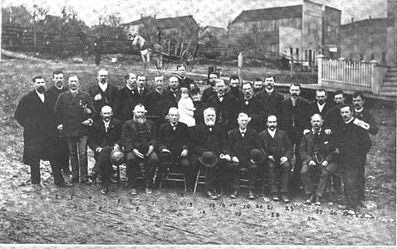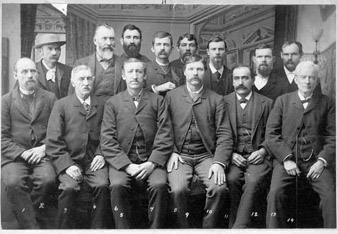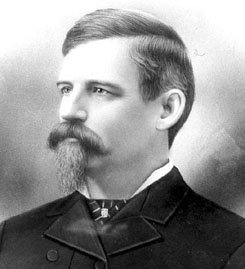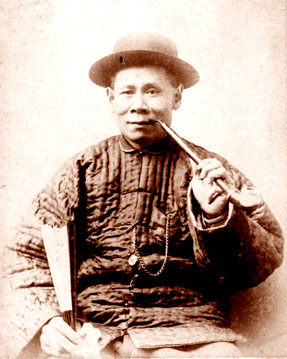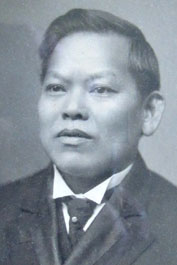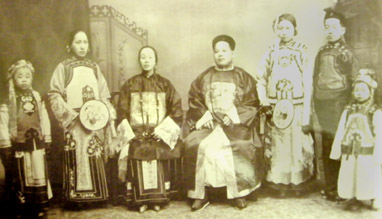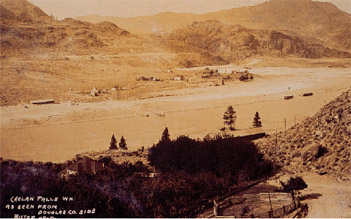VIOLENCE-2 排华暴力事件-2
This page is an annex of the main page on anti-Chinese violence in North America during the 19th and early 20th centuries. Readers may find that the main page is better for browsing. Or they can consult the following index.
This page was last updated: August 30, 2018
Anti-Chinese incidents in the Pacific Northwest: a new map [posted 08/03/10; updated 10/17/11]
President Taft's list of incidents [posted 10/8/11]
The Anti-Chinese conspirators 1885-1887 [posted 01/20/10]
Death record of Chinese victims [posted 01/14/10]
Profiting from expulsion: white ladies and teapots [posted 10/18/11]
An honor roll of the victims [posted 02/20/11]
Chinese traders' reaction and Tacoma's defiance [posted 07/08/11, updated 10/17/11]
The long-term cost to Tacoma [posted 09/15/10]
The Tacoma Art Museum sells a collection donated in memory of the expulsion (posted 03/04/2013,
Chinese officials warn Governor Squires [posted 10/10/11]
Woo Gen remembers losing his Chinese business [posted 01/07/10]
Mrs. H. Scovile remembers "buying" a Chinese business [posted 03/10/10]
The Chinese victims [posted 02/14/11]
Mrs. Chin Gee Hee miscarries due to the riot [updated 10/9/11]
Members of the anti-Chinese mob [posted 02/14/11]
Chin Bong remembers [posted 01/07/10]
Ambassador Chang Yen Hoon protests [posted 10/04/10]
New data: Chinese names and home village of the victims [posted 10//5/11]
Finding Xialiang, the victim's village in China [posted 12/14/11]
The role of Portland's Chinese [posted 10//5/11]
Plans: a memorial for a massacre [posted 10//5/11]
What did Chinatown leaders do to avert violence? Did they succeed? [posted 04/06/11]
The Chelan Massacre: The worst incident of anti-Chinese violence in U.S. history [posted 04/21/2013]
 | ||||
The Tacoma Method, November 1885
华盛顿州塔可玛排华自成一家
The citizens of Tacoma took pride in their system for expelling all 500 Chinese residents through threats and forcible assistance but with no overt violence. The system, dubbed the "Tacoma Method," was extolled in an article by George Dudley Lawson published nationwide in the Overland Monthly (1886:234-240). A key feature of the method was the wholehearted involvement of the mayor and the chief of police.
It was only because of the active participation of the sober, intelligent, and respectable citizens, whose motives could not be questioned or integrity impeached, that a speedy and peaceful result was reached. The few interested men who would have espoused the cause of the Mongolians [i.e., the Chinese],.were overwhelmed and awed when they saw the class and character of those arrayed against them.
Similar, equally boastful, sentiments were expressed in a letter from one of the ringleaders to the governor in Olympia, the capital of Washington Territory:
Letter from John Arthur to Governor Watson C. Squire, Olympia
TACOMA, November 4, 1885
DEAR GOVERNOR. Fuit Ilium. The Chinese are no more in Tacoma, and the trouble over them is virtually at an end. Yesterday they were peaceably escorted out of town and put upon the freight and passenger trains this morning. Do you recall what I told you as to the method which I understood would be adopted on the last days? It was strictly followed with the exception that the train was not special, the reason for this departure from the programme being that the price asked for a special train was too exorbitant.
The twenty or thirty Chinamen who were permitted to remain a day for purposes of packing and shipping store-goods will leave tomorrow morning; then Tacoma will be sans Chinese, sans pigtails, sans moon-eye, sans wash-house, sans joss-house, sans everything Mongolian... Those who predicted differently were partly swayed by their wishes and greatly underrated the intelligence, character, and resolution of the men who worked up the movement and who were flippantly called a rabble by their moral and intellectual inferiors.
The expulsion, though "peaceful," was not entirely without casualties. Two Chinese died of exposure that night before being herded onto a train the following morning. The wife of one Chinese merchant became insane "from fright and anxiety." The whole of Chinatown was burned to the ground the day afterward.
And it goes without saying that not everyone agreed about the character and respectability of Tacoma's citizens. They were (and still are) called a disgraceful rabble by many non-Tacomans.
Source: Report of the Governor of Washington Territory to the Secretary of the Interior, Government Printing Office: Washington DC, 1886, pp 875, 908)
The Long-Term Cost to Tacoma
Tacoma did not do well after the Chinese were driven out. While it is hard to believe that the loss of a few hundred residents, no matter how enterprising and hard-working, could have hurt the city's economy all that much, it remains a fact that as the decades passed, Tacoma fell further and further behind Seattle in terms of population and prosperity. Today Tacoma is not a wealthy city. It also has a very small Chinese population relative to its size, as the following table shows.
ASIANS IN TACOMA. 2006-2008
City of Tacoma  Washington State
Washington State
Chinese


 727
727 0.4%
0.4%
 84,400
84,400 1.3%
1.3%
from ACS (American Community Survey, Dept of Census), Demographic and Housing Estimates, 2006-2008,
http://factfinder.census.gov/servlet/ADPTable?_bm=y&-geo_id=04000US53&-qr_name=ACS_2008_3YR_G00_DP3YR5&-ds_name=ACS_2008_3YR_G00_&-_lang=en&-redoLog=false&-_sse=on
Why should this be so? Very few present-day immigrants to Washington State know about the Method and the savage racism behind it, and in any case Tacoma has long since abandoned those attitudes. On a state-wide basis it has more than its share of Asians within its boundaries. Its Filipinos, Vietnamese, and Koreans do not experience more discrimination than elsewhere in the Northwest. And yet Tacoma still has less than a third as many Chinese as it should. Again, why?
The Tacoma Victims - Who Were They? 塔可玛受害者名单
The buildings for business and residence below were burned and everything was lost: nine eateries, two butcher shops, 2 laundries, 1 herbal drug store, and three residences. The majority of owners had the surname Ruan [in Cantonese, Goon], while a few were named Chen [Chin], Wu [Eng, Ng], or Tang [Hong].
The following businesses and residences lost their savings, merchandise, furnishings, and belongings: 11 laundries, 4 groceries, and 1 tailor's shop, run by people with the surnames (in Mandarin) Chen, Lin, Wu-ren, Wu-tian, Li, He, Zhou, Luo, Huang, and Ruan.
- Bing Chong Laundry, 明昌洗衣馆。 黄/ 李
Bing Chong Laundry, 明昌洗衣馆。 黄/ 李
- Duck Kee Laundry , 德记洗衣馆。 陈焕国
Duck Kee Laundry , 德记洗衣馆。 陈焕国
- Duck Lee Laundry ,德利洗衣馆。 陈祥谋
Duck Lee Laundry ,德利洗衣馆。 陈祥谋
- Foo Tai Laundry, 普泰洗衣馆。 阮松胜
Foo Tai Laundry, 普泰洗衣馆。 阮松胜
plus Kim Lee, Kwong Wa, Hi Co., Yee Fot & Co., Chong Dan, Ng Yot Hong, Ah Dan, Ng Sheow Yan, Wah Lee, Jim Kee.
Sources: List of Tacoma Chinese Business lost in 1885, University of Washington Libraries, Digital Collection.
Names in red also appear in Annual Report of the Governor of Washington Territory (to the Secretary of the Interior), p.56,
Schedule of Claims for Losses by the Chinese, 1886
Tacoma was known as 的钦巴案 in Chinese government documents, the Federal government paid an indemnity in 1888.
"Reconciliation" and the Park
Making very tardy amends, the Tacoma City Council passed a resolution in 1993 stating that the expulsion "was a most reprehensible occurrence." In 2005 the city broke ground for a commemorative space to be named, curiously, Reconciliation Park. On October 30, 2010, a Walk for Reconciliation took place in Tacoma, to mark the 125th anniversary of the driving-out. The park opened officially in September 2011. It featured the moving, bleak landscape shown below plus a colorful pavilion. The latter was donated by Tacoma's sister city in China, Fuzhou. It went into the park even though few if any Fuzhounese (speakers of the Minbei dialects of northern Fujian province) would come to North America until a century after their fellow countrymen (all of them Cantonese, Taishanese, and Hakka speakers from Guangdong province) were expelled from Tacoma
"Flippantly called a rabble": the 27 Tacomans indicted for the expulsion
The Committee of Fifteen. E. H. Bacon is 3rd from left
“At the sound of the whistles scores of men poured into the streets and each knew just what to do. It was a mob but an orderly mob as mobs go. There was excitement to be sure but the raiders did not lose their heads. Perhaps that was because they had already been lost. The first Chinese shack visited was at about where the Massasoit Hotel stands, and the raiders then visited one shack after another all the way from Seventeenth Street to Old Tacoma. One after another of the terrified Chinese ordered express wagons and began loading their plunder. Many of them, however, left behind everything except their money. Several of them [at least thirteen--see "Victims" below] were laundrymen and they departed leaving their patrons’ shirts and collars, some in the tubs and some ready for delivery. Much of the community linen was lost as marauders robbed the laundries. In some instances white women entered the Chinese shacks and procured souvenirs, There are a number of prized teapots in Tacoma cupboards to this day”
Herbert Hunt Tacoma: Its History and its Builders; a half century of activity, Vol. 1 Chicago, 1916 p 373
Profiting from Expulsion: White Ladies and Teapots
Not all anti-Chinese Tacomans were as high-minded as those described by George Dudley Lawson in his Overland Monthly article (see the preceding section). The motives of some were just as questionable as those of Mrs. Scoville in Seattle, who happily remembered getting a profitable laundry at a bargain price when its Chinese owner was driven out. Tacoma examples include the women who, Herbert Hunt wrote, acquired prized teapots from Chinese shacks for free. Hunt thought the story was cute. To us, it seems embarrassing.
The City Council could have chosen a more appropriate name than "Reconciliation Park," implying as it does that both sides were at fault -- presumably, the white Tacomans for driving the Chinese out and the Chinese either for causing the whites to drive them out or for failing to forgive them afterward.
As of now, 2011, no one seems to be objecting to the name. We do not quite understand why. But it seems to us to be in character with earlier efforts by Tacomans to absolve themselves of guilt. In recent years they have no longer tried to excuse their predecessors' actions. And yet they still seem to find it hard to accept that those actions were as one-sidedly demeaning to the city as they seem to non-Tacomans.
Reference: the Chinese Reconciliation Project's website, www.crpftacoma.org/; see also the maps at Tim Greyhavens' http://www.what-you-see.com/washington/Map_of_the_Tacoma_Anti-Chinese_Riot.pdf
For more details of the expulsion and the Chinese Remembrance Project, see http://iexaminer.org/cerp/history-expulsions
The bleak shoreline landscaping of Reconciliation Park, Tacoma
 | ||||
It was only because of the active participation of the sober, intelligent, and respectable citizens, whose motives could not be questioned or integrity impeached, that a speedy and peaceful result was reached. The few interested men who would have espoused the cause of the Mongolians [i.e., the Chinese],.were overwhelmed and awed when they saw the class and character of those arrayed against them.
Similar, equally boastful, sentiments were expressed in a letter from one of the ringleaders to the governor in Olympia, the capital of Washington Territory:
Letter from John Arthur to Governor Watson C. Squire, Olympia
TACOMA, November 4, 1885
DEAR GOVERNOR. Fuit Ilium. The Chinese are no more in Tacoma, and the trouble over them is virtually at an end. Yesterday they were peaceably escorted out of town and put upon the freight and passenger trains this morning. Do you recall what I told you as to the method which I understood would be adopted on the last days? It was strictly followed with the exception that the train was not special, the reason for this departure from the programme being that the price asked for a special train was too exorbitant.
The twenty or thirty Chinamen who were permitted to remain a day for purposes of packing and shipping store-goods will leave tomorrow morning; then Tacoma will be sans Chinese, sans pigtails, sans moon-eye, sans wash-house, sans joss-house, sans everything Mongolian... Those who predicted differently were partly swayed by their wishes and greatly underrated the intelligence, character, and resolution of the men who worked up the movement and who were flippantly called a rabble by their moral and intellectual inferiors.
The expulsion, though "peaceful," was not entirely without casualties. Two Chinese died of exposure that night before being herded onto a train the following morning. The wife of one Chinese merchant became insane "from fright and anxiety." The whole of Chinatown was burned to the ground the day afterward.
And it goes without saying that not everyone agreed about the character and respectability of Tacoma's citizens. They were (and still are) called a disgraceful rabble by many non-Tacomans.
Source: Report of the Governor of Washington Territory to the Secretary of the Interior, Government Printing Office: Washington DC, 1886, pp 875, 908)
ASIANS IN TACOMA. 2006-2008
City of Tacoma  Washington State
Washington State
Chinese


 727
727 0.4%
0.4%
 84,400
84,400 1.3%
1.3%
from ACS (American Community Survey, Dept of Census), Demographic and Housing Estimates, 2006-2008,
http://factfinder.census.gov/servlet/ADPTable?_bm=y&-geo_id=04000US53&-qr_name=ACS_2008_3YR_G00_DP3YR5&-ds_name=ACS_2008_3YR_G00_&-_lang=en&-redoLog=false&-_sse=on
The Tacoma Victims - Who Were They? 塔可玛受害者名单
The buildings for business and residence below were burned and everything was lost: nine eateries, two butcher shops, 2 laundries, 1 herbal drug store, and three residences. The majority of owners had the surname Ruan [in Cantonese, Goon], while a few were named Chen [Chin], Wu [Eng, Ng], or Tang [Hong].
The following businesses and residences lost their savings, merchandise, furnishings, and belongings: 11 laundries, 4 groceries, and 1 tailor's shop, run by people with the surnames (in Mandarin) Chen, Lin, Wu-ren, Wu-tian, Li, He, Zhou, Luo, Huang, and Ruan.
- Bing Chong Laundry, 明昌洗衣馆。 黄/ 李
Bing Chong Laundry, 明昌洗衣馆。 黄/ 李
- Duck Kee Laundry , 德记洗衣馆。 陈焕国
Duck Kee Laundry , 德记洗衣馆。 陈焕国
- Duck Lee Laundry ,德利洗衣馆。 陈祥谋
Duck Lee Laundry ,德利洗衣馆。 陈祥谋
- Foo Tai Laundry, 普泰洗衣馆。 阮松胜
Foo Tai Laundry, 普泰洗衣馆。 阮松胜
plus Kim Lee, Kwong Wa, Hi Co., Yee Fot & Co., Chong Dan, Ng Yot Hong, Ah Dan, Ng Sheow Yan, Wah Lee, Jim Kee.
Sources: List of Tacoma Chinese Business lost in 1885, University of Washington Libraries, Digital Collection.
Names in red also appear in Annual Report of the Governor of Washington Territory (to the Secretary of the Interior), p.56,
Schedule of Claims for Losses by the Chinese, 1886
Tacoma was known as 的钦巴案 in Chinese government documents, the Federal government paid an indemnity in 1888.
Hong Kong Traders' Reaction and Tacoma's Defiance
In 1892, George B. Dodwell, influential owner of the Northern Pacific Oriental Steamship Co., stated that if Chinese were not allowed to come back to Tacoma, "his steamship[s] would be discriminated against by Chinese merchants [in Hong Kong] controlling the flour trade of the Orient."
Tacoma's Committee of Fifteen, which had been organized to oversee the 1885 expulsions, replied, "at a meeting held today, it was resolved unanimously that the committee would not endorse any proposition allowing a Chinese business house, conducted by Chinese, to be established in Tacoma; and will not be responsible, individually or collectively, for the consequences that may ensue should said house be brought here. [Signed] E H. Bacon, Chairman H. C. Patrick, Secretary"
"Flippantly called a rabble": the 27 Tacomans indicted for the expulsion
The Committee of Fifteen. E. H. Bacon is 3rd from left
The Northern Pacific Railroad, which later bought the steamship company, carried large amounts of flour to its terminal in Tacoma. The flour was shipped to Alaska, California, and Japan. While some must have gone to China too, in spite of the Chinese merchants Dodwell mentions, the Committee of Fifteen's threatening attitude must have pleased flour exporters in Seattle, Tacoma's somewhat less prejudiced rival.
Dodwell, incidentally, was also the owner of the Hong Kong trading firm, Dodwell Carlill & Co. He would have known what he was talking about when he said that Chinese flour importers might well boycott Tacoma.
Sources: Seattle Post-Intelligencer 1892-07-20, p 2. On Dodwell, see Victoria (BC) Daily Colonist 1892-06-19, p 6.
“At the sound of the whistles scores of men poured into the streets and each knew just what to do. It was a mob but an orderly mob as mobs go. There was excitement to be sure but the raiders did not lose their heads. Perhaps that was because they had already been lost. The first Chinese shack visited was at about where the Massasoit Hotel stands, and the raiders then visited one shack after another all the way from Seventeenth Street to Old Tacoma. One after another of the terrified Chinese ordered express wagons and began loading their plunder. Many of them, however, left behind everything except their money. Several of them [at least thirteen--see "Victims" below] were laundrymen and they departed leaving their patrons’ shirts and collars, some in the tubs and some ready for delivery. Much of the community linen was lost as marauders robbed the laundries. In some instances white women entered the Chinese shacks and procured souvenirs, There are a number of prized teapots in Tacoma cupboards to this day”
Herbert Hunt Tacoma: Its History and its Builders; a half century of activity, Vol. 1 Chicago, 1916 p 373
Profiting from Expulsion: White Ladies and Teapots
Not all anti-Chinese Tacomans were as high-minded as those described by George Dudley Lawson in his Overland Monthly article (see the preceding section). The motives of some were just as questionable as those of Mrs. Scoville in Seattle, who happily remembered getting a profitable laundry at a bargain price when its Chinese owner was driven out. Tacoma examples include the women who, Herbert Hunt wrote, acquired prized teapots from Chinese shacks for free. Hunt thought the story was cute.
The bleak shoreline landscaping of Reconciliation Park, Tacoma
Notes
1. Report of the Governor of Alaska for the Fiscal Year 1886. Government Printing Office: Washington 1886. pp 38-46
2. San Francisco Chronicle 1886-04-08, p 6
3. Same, 1884-07-14, p 2
4. New York Times 1886-01-29, p 3
5. Report of the Governor ... 1886, p 40
6. Same, p 41
7. New York Times 1886-08-24, p 4
8. Zhang Yinhuan [Chang Yen Hoon], Three Continents Diary, 1896 (in Chinese)
9. Papers Relating to the Foreign Relations of the United States . . . December 3, 1888. Government Printing Office, Washington, 1889, p 365
10. www.historylink.org/index.cfm?DisplayPage=output.cfm&file_id=9026; and www.library.state.ak.us/hist/hist_docs/finding_aids/MS141.doc).
11. Joe Tang, “Lonesome Land,” Hypen Magazine, Issue 6
Douglas Island, Juneau, Alaska 1886
阿拉斯加州朱諾地区的道格拉斯島
On August 6, 1886 a mob of 100 American workers rowed across from Juneau to nearby Douglas Island, where John Treadwell’s Alaskan Mill and Mining company had hired 80 Chinese miners through a labor contractor in San Francisco. The mob seized the Chinese, dragged them back to Juneau, packed them onto two small schooners ships, the Nellie Martin and the Charlie, and sent them out to sea with a little rice, no warm clothing, and minimal protection from the rain and wind. It took the schooners, with sails but no engines, between two and four weeks to cover the 150 miles to Wrangell, a small coastal town even more isolated than Juneau. There again they had no shelter and little food. Luckily, a passenger vessel, the steamship Ancon, came by and agreed to take everyone back to Juneau. That return trip cannot have taken more than a day or two, but when they arrived an armed mob refused to let them land. They had to borrow money from their employer to pay for passage back to San Francisco. Amazingly, though completely destitute, none of them died (Note 1).
Treadwell’s mine on Douglas Island was said to be “the largest and most promising property in Alaska” and was already well known in mining circles for its size and profitability (Note 2). Chinese had been working there since 1884 (Note 3). The abrupt demand for their expulsion two years later was undoubtedly inspired by the drivings-out of Chinese in 1885-6 back in the contiguous United States.
That anti-Chinese violence was coming had been clear since January, when a house occupied by Chinese in Juneau was dynamited, without loss of life but extensive damage to non-Chinese buildings nearby. Some townspeople were reported to be outraged and offered a $1,400 reward for capture of the perpetrators. The reward was never claimed (Note 4).
Eight months later on August 5, the anti-Chinese forces were ready for more decisive action. A group of white workers confronted Treadwell in Juneau and demanded that he fire all of his Chinese employees. To his credit, Treadwell refused. But the next day, a well organized mob rowed over to Douglas Island to enforce their demands. Every Chinese they could find was rounded up.
The territorial governor in Juneau, A. P. Swineford, attempted half-heartedly to restore peace and order. No arrest could be made because the Deputy U. S. Marshall in Juneau stated that “he absolutely refused to make complaint against those of the ringleaders who were personally known to him.” (Note 5) Moreover, it was impossible, the Governor claimed, to bring the Chinese back. He had requested a locally based Navy ship to pursue the
schooners. However, the ship’s commanding officer, . Lieutenant Commander Henry E. Nichols, refused. In a series of memos, he wrote that his forces were too limited and anyway that he was due to leave in three weeks’ time for Yakutat to relieve an exploring expedition. The incident led Swineford to conclude that there was no way for the Chinese to be protected even if they came back, considering the hostility of the local population and the unwillingness of the Navy to take action. His own authority was limited. As he pointed out, most of the perpetrators were aliens. “No more than a dozen of the men who constituted the mob in question were citizens of the United States, either by birth of adoption, the very large majority being men who, in a political or any other sense, have no more, if as much, right to consideration as the Chinese themselves.” (Note 6)
… there were 87 of them in all, and they so crowded the boat that there was not even room for them to lie down. To add to the brutality of the expulsion, they were given nothing to shelter them from the inclement weather and barely rice enough to keep them from starving on their four weeks’ trip along the coast to Fort Wrangle. . . it was a most cowardly and inhuman proceeding.”
Hammond also reported a rare reaction from the Chinese, “somewhat to the astonishment of their employers, the Chinamen expressed a readiness to stay and fight, but being unarmed, ….” (Note 7)
Chang Yen-Hoon, the Chinese Ambassador in Washington D.C., was notified of the Douglas Island incident on August 16, by the Chinese Consul General in San Francisco. In February of the following year, Chang received a claim of $13,000 from the Alaskan Chinese, among them one Feng Guangsheng 冯广盛 (Note 8). This Feng may have been identical with Fung Ah Soey, a native of Sun Ning, reported in Chang’s English-language correspondence with Bayard, the Secretary of State, to have submitted the claim for damages. The same letter names four of the ringleaders of the mob in Juneau: Jack Timmers, Patrick McGliney, Frank Berry, and George Wheelock (Note 9). None were investigated or punished.
In later years, Chinese came back to southern Alaska to work in salmon canneries and in mining. Ironically, one of the principal owners of the very successful Chichagof-Hirst gold mine, only sixty miles from the Treadwell mine, was the Chinese merchant Goon Dip 阮洽 of Portland and Seattle. Goon bought a share of the mine in about 1920 and with his son-in-law, Lew Kay, continued to be active in the mining company until the 1940s (Note 10)
Although no loss of life seems to have occurred, the event shocked an eyewitness, J. B. Hammond, to tell his story in Chicago when he returned from Alaska two weeks afterwards. A visiting engineer and contractor , Hammond reported that
Alfred P Swineford, Governor of the District
of Alaska, 1885-1889 (Image from Wikipedia) .
Treadwell Mine in 1896 Image from Wikimedia
One Chinese baker in Juneau, China Joe (or Chew Chung Thui), stayed on after the expulsion of his countrymen. Legend had it that he was so well liked by Juneau citizens that he was saved from any harm. (Note 11).
Goon Dip
China Joe
The Ironic Fate of One of the Fifteen
The Fifteen were not locally well known before they invented the Method and did not become prominent afterward. Most remained obscure in spite of attempts, as in 1892, to resurrect local anti-Chinese feelings. At least one of the Fifteen left Tacoma to seek his fortune elsewhere In 1909, he was reported to be in Hawaii where, it was claimed, he found himself forced to work for a Chinese employer.
Source: Clinton Snowden, History of Washington, New York, vol. 4, p 345
(UNLESS OTHERWISE STATED ALL DATA ON THIS PAGE COMES FROM THE EDITORS' OWN RESEARCH ON PRIMARY SOURCES & ARTIFACTS)
2013: The Tacoma Art Museum Sells a Chinese Collection, Donated in Memory of the 1885 Driving-Out?
In 1976, Colonel John and Mary Young, second-generation Chinese American restaurateurs from San Francisco, donated much of their collection of Chinese art to the Tacoma Art Museum. According to their son Al Young (of Shoreline, WA) in an interview with the Seattle Times, "they chose TAM, in part, because of the city's history of anti-Chinese sentiment." In December, 2012, TAM sold a third of the collection at auction and planned to sell the remaining two-thirds in March, 2013. The December sale netted $230,000. "Hey, it was a great day for us," said TAM's director, Stephanie Stebich (Note 1).
Many Chinese Americans in Tacoma and elsewhere in the Puget Sound area are unhappy. However, TAM maintains that the sale was justified. "Deaccessioning – the process of selling, giving away or destroying items a museum no longer wants to keep in a collection – is a common practice with official guidelines. Selling items that don’t support a museum’s focus is a routine part of this," Stebich noted," going on to say that the museum had decided in the future to focus exclusively on Northwestern art. She expressed hope that this might include art by local Chinese artists. “We are selling these items to build a collection that helps tell the story about the Chinese in the Northwest through art,” she said. “Help me understand how Chinese Imperial robes do that.” (Note 2)
In implying that Chinese imperial robes are irrelevant to the story of Chinese in the Northwest, Ms. Stebich was incorrect. Quite a few important Chinese individuals in the early Pacific Northwest wore (and were entitled to wear) imperial robes. These included Moy Back Hin 梅伯显 and Goon Dip 阮洽, both of whom held official Chinese government posts, as well as Chin Gee Hee 陈宜禧 and Victoria's Lee Mong Kow 李梦九. Moreover, larger numbers of such robes were seen in Seattle, Victoria, Vancouver, and Portland whenever Imperial diplomats or officials passed through and were formally greeted by local Chinese Americans -- for instance, when Viceroy Li Hongzhang visited Victoria in 1886 and when Prince Tsai Tseh visited Seattle in 1906. Certain of those visits marked turning points in the story of Chinese in the Northwest. The robes would seem to be more relevant to that story than most works by modern Chinese American artists in our region. FOR MORE ON THE NORTHWESTERN CHINESE AND IMPERIAL ROBES, CLICK HERE.
A relevant historical detail. Even though TAM has repeatedly announced its intention to focus exclusively on Northwestern art, last summer it accepted a major 280-piece collection of non-Northwestern art -- paintings depicting the American Southwest and Great Plains -- donated by Erivan Haub, a German billionaire. "In a News Tribune story in July [2012], Stebich said TAM was 'broaden(ing) our definition of Northwest and the West in light of the Haub gift.' "(Note 3) Judging from available on-line images of Haub's paintings, TAM's definition did indeed have to be broadened. Very few of those paintings are of Northwestern subjects or by Northwestern artists.
A person not connected with TAM might think that the deaccessioned Chinese objects were at least as significant to Pacific Northwesterners as paintings of Indian pueblos in Arizona or of cowboys in Colorado.
Note 1 Seattle Times, 2013-03-04, pp 1 & 4.
Note 2 Bellingham Herald, 2013-03-03 Click here for article
Note 3. Tacoma News Tribune, 2013-03-04, p 1 & 4 Click here for article
Consul Goon Dip and wife in official Imperial robes, ca. 1910. In private life, Goon was a successful Portland-Seattle businessman
The day after the above news broke, the Tacoma Art Museum issued a press release stating that the dispute had been resolved and that the donors' family were satisfied by the museum's promise to use part of the sales proceeds to buy modern works by Chinese American artists in the Northwest, to name the Young family as donors of these future acquisitions, and to donate a few of the objects involved to another (unspecified) museum.
The Northeast Asian Weekly broke the story several days before most of the Seattle-area media. A few days later, its editor, Assunta Ng, expressed her feelings about the settlement of the dispute in these words. Like the editors, she was under the impression that the gift had been connected with the 1885 expulsion.
"The family had donated their collection, without restrictions and legally, the museum could do anything they wanted with it. What they chose to do was completely legal, but it was unethical. Museums ... should be aware of the history and context that they exist in. The Tacoma Museum apparently didn't ...
The gift was, in part, to help heal the pain [of the 1885 expulsion]. The donation helped bring Chinese culture back to the city--one of the largest cities without a Chinatown--and helped show that Tacoma did value Chinese culture. Even though it was completely within the Tacoma Art Museum's rights to auction the donation, it was a short-sighted decision ...
The family eventually sued and then quickly dropped their lawsuit. Now, the Tacoma Art Museum has promised not to auction all the robes, but to also donate a few to a local institution. That's good, but did we need to take so long to get to this point?
-- Editorial, Northwest Asian Weekly, 2013-03-09, p 11
3/20/2013. The editors just had a telephone conversation with Ms. Stebich. She tells us that a careful search through TAM's records shows no sign that the donors, the Youngs, had been thinking of the 1885 Expulsion when they made the gift. We believe her. TAM's staff may not have been alert to the implications of their deaccession plans, but they seem not to have acted in bad faith with regard to the donors' wishes.
The Chelan Massacre Reconsidered
The massacre has been described by a number of secondary and tertiary sources. Gaylord (1992, p 27) states that about 300 Chinese were killed. Hildebrand (1977, p 17) reports the same incident but did not estimate the number killed. Writing from a sympathetic pro-Indian perspective, Ruby & Brown (1995, p 47) and Marchand (2013, p 36) both accept that the massacre happened, and Marchand goes along with the 300 figure as well. The latest edition of the Chins' influential history of the Chinese in Washington (2013, p 12) agrees with these earlier sources while reserving judgement as to the number of Chinese miners that were murdered.
When most interested people think of anti-Chinese cruelty and violence in nineteenth century North America, they think of the Rock Springs massacre or, perhaps, the largely mythical death rate suffered by the builders of the first transcontinental railway. Not many realize that central Washington State saw a far worse case: the horrifying massacre of Chinese miners on the bluffs of the Columbia just south of Chelan Falls in 1875. Several hundred Chinese were systematically murdered by Okanogan, Methow, Chelan, and Entiat Indians. As part of the Native American resistance movement led by Chief Moses, the perpetrators may have thought themselves justified. Yet it was an evil set of actions, and a racist one at that. They only killed Chinese.
In spite of all these opinions, we were skeptical.. The story sounded too sensational and too charged with racist stereotypes. Hence, we were inclined to class it as yet another example of the mythical Chinese killings that have long obsessed writers on Chinese North American history. Our suspicions were strengthened when we read an admirably clear-headed article written in 2011 by Concie Luna, in which she reviews and dismisses a number of obviously untrue secondary accounts ("A Chinese Puzzle," The Lake Chelan Historical Society History Notes, Vol 26, pp 8-11, 2011).
But now we are afraid we have to change our minds. The reason why is that we found the following, by a writer who not only had a contemporary 1875 newspaper article in front of him but who also visited the Chelan area in about 1900, when persons with personal knowledge of the massacre and its social context were still alive.
"All this was in 1875. It was, practically, an Indian war against the Chinese that drove them away, but at the time this was not generally known. Along the Methow river the savages began attacking the Chinese of whom they killed several. The news rapidly circulated among their comrades. When the Siwashes came to the settlement intent on its demolishment, they found nobody save a few stragglers. There were several sharp skirmishes in which some were killed on both sides. A correspondent of the [Spokane] Spokesman-Review says :
" 'When the Indians reached a point on the Columbia a few miles below where Chelan Falls now stands they discovered a number of Chinamen at work on the benches three hundred feet above. The savages advanced cautiously and surrounded the Celestials on three sides, leaving only the steep bluffs unguarded. Then began an uneven fight. The Chinamen were unprotected and unable to escape, and they proved an easy prey to their savage antagonists. How many were massacred was never known, but it is positive that not one was left to tell the tale. It was an awful fight, that sent terror into the hearts of the other Chinese along the river.
" 'After that there was little placer mining done for months, then one by one the Celestials returned, but never could one of them be induced to go on the bench where the massacre occurred and open up the diggings again. Today they are in exactly the same condition as that in which they were when the workers were slaughtered by the Indians.
" 'Now the placer fields of the past are owned by settlers, and are fast becoming beautiful fruit orchards. . .' " (Steele 1904)
The Columbia River at Chelan Falls, before 1922, looking west. The massacre took place on the "bench" (the natural terrace) about halfway up the mountain on the west side of the river. Photo credit: Chelan Falls Public Utility District
Chin, Art & Doug. The Chinese in Washington State. Seattle: OCA Greater Seattle, 2013
Gaylord, Mary. Eastern Washington's Past and Present: Chinese and Other Pioneers. U. S. Dept. of Agriculture,
Hildebrand, Lorraine Barker. Straw Hats, Sandals, and Steel: The Chinese in Washington State. Tacoma:
Marchand, Arnie. The Way I Heard It: A Three Nation Reading Vacation. Xlibris Corp., 2013
Ruby, Robert H. & John A. Brown. Half-Sun on the Columbia: A Biography of Chief Moses. Norman: U. of
Steele, Richard F. An Illustrated History of Stevens, Ferry. Okanagan, and Chelan Counties. Spokane: Western
Wilma, David. "Chelan County: Thumbnail History." Historylink, 2006.
This seems convincing enough. We now believe that the Chelan massacre did happen, and that it involved many more Chinese casualties than any other violent event in the history of this state or, indeed, of anywhere else in the United States or Canada. All Americans should learn about and remember Chelan.
